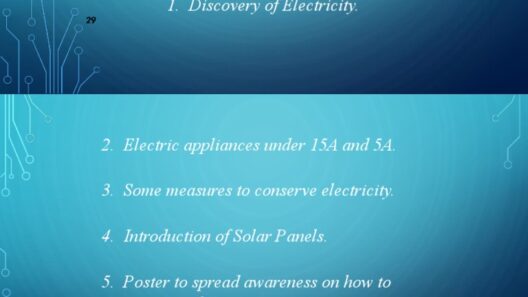Energy conservation measures (ECMs) encompass a variety of strategies and practices aimed at reducing energy consumption while maintaining the same level of service or comfort. With the rampant escalation of energy costs and the urgent need to mitigate climate change, these measures are garnering increased attention. But what precisely are ECMs, and why are they becoming a focal point in discussions about energy usage and sustainability? Let’s delve deeper into this imperative subject.
At its core, an energy conservation measure constitutes any action that leads to less energy use. This can involve technological upgrades, behavioral shifts, or the adoption of alternative energy sources. The definition is broad, encompassing everything from simple daily habits—like turning off lights when leaving a room—to complex infrastructural changes, such as retrofitting a commercial building with energy-efficient systems. But herein lies a provocative question: What if we collectively committed to reducing our energy consumption by just 10%? What challenges and transformations would that entail?
Initially, it is essential to recognize the various categories of energy conservation measures. They can be primarily divided into two distinct yet interrelated categories: passive and active measures. Passive measures focus on architectural and design modifications that enhance energy efficiency. Consider the installation of insulation, the strategic placement of windows for natural light, or the implementation of green roofs. These adaptations do not require continuous action but offer long-term energy savings.
On the other hand, active measures involve technological upgrades or changes in behavior that require ongoing effort. Replacing incandescent light bulbs with LED alternatives, procuring Energy Star-certified appliances, or utilizing smart thermostats to regulate heating and cooling in real time exemplifies active measures. When these actions are embraced on a wide scale, they can lead to significant reductions in energy consumption.
Why should one invest time and effort in understanding and applying ECMs? The rationale is multifaceted. Firstly, the environmental aspect is undeniable. The burning of fossil fuels for electricity generation remains one of the leading contributors to greenhouse gas emissions—substantially impacting global warming and air quality. By adopting ECMs, individuals and organizations can play a pivotal role in diminishing their carbon footprints, thereby contributing to a healthier planet.
Secondly, energy conservation measures have palpable economic benefits. According to studies, organizations that implement ECMs can enjoy reduced operational costs. Imagine the cumulative savings for a manufacturing firm that invests in energy-efficient machinery! The return on investment (ROI) can be impressive, not only improving profitability but also providing funding for further sustainability initiatives.
Moreover, there is a growing trend among consumers who prefer to patronize eco-conscious businesses. By adopting energy conservation measures, companies can bolster their brand reputation and attract a broader customer base. Environmentally-aware consumers are increasingly willing to support brands that demonstrate a commitment to sustainability.
In terms of practicality, energy conservation measures can be implemented across sectors—from residential homes to industrial operations. Residential energy audits can reveal opportunities for conservation, such as sealing drafts, upgrading insulation, and improving heating systems. Commercial buildings can adopt LED lighting, control systems for energy use, and invest in renewable energy sources like solar panels. Each of these measures stands to yield substantial energy savings.
However, the journey toward adopting ECMs is fraught with challenges. The initial cost of implementing certain measures, such as retrofitting buildings or acquiring energy-efficient appliances, can be a significant barrier. This paradox often leads to hesitation—individuals and businesses frequently weigh immediate costs against long-term savings, sometimes opting for short-term convenience over sustainable investments.
Cultural habits also present formidable challenges. Changing how people interact with energy—encouraging them to turn off appliances when not in use or maintain moderate temperatures—requires persistence and education. Who said behavioral change would be simple? To engage communities, education campaigns may be necessary, highlighting the urgent need for behavior shifts to achieve significant energy reductions collectively.
It prompts another question: How can cities and municipalities incentivize ECM adoption? Policymakers play a crucial role in facilitating energy conservation. Incentives like tax rebates for energy-efficient upgrades or subsidies for renewable energy installations can motivate individuals and companies to embrace sustainable practices. Community-led initiatives can foster camaraderie around energy-saving practices, enriching the social fabric while promoting sustainability.
Furthermore, technological advancements will fuel the evolution of energy conservation measures. The integration of the internet of things (IoT) in homes and businesses can allow for real-time energy monitoring, enabling consumers to make informed decisions about their energy use. Smart meters, energy management systems, and real-time data analytics can advance our approaches to energy conservation, transitioning from reactive to proactive management of energy resources.
In conclusion, energy conservation measures are not just beneficial; they are imperative in addressing the multifarious challenges posed by climate change and rising energy costs. As we reflect on our individual and collective capabilities, the overarching mission becomes clear—embracing ECMs is not merely an option but a necessity for a sustainable future. When we engage with energy conservation measures, we embark on a path that not only reduces our ecological impact but also fosters economic stability and communal success. Are we ready to accept this challenge and initiate the change that is so desperately needed?








